brake light YAMAHA XMAX 125 2008 Owners Manual
[x] Cancel search | Manufacturer: YAMAHA, Model Year: 2008, Model line: XMAX 125, Model: YAMAHA XMAX 125 2008Pages: 88, PDF Size: 2.61 MB
Page 6 of 88
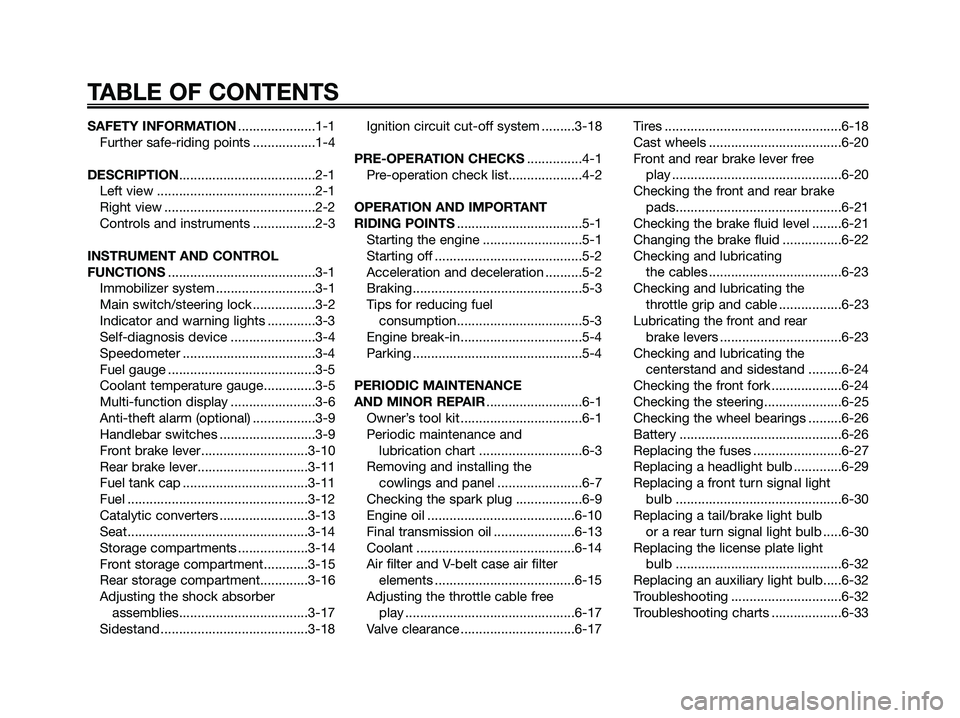
SAFETY INFORMATION.....................1-1
Further safe-riding points .................1-4
DESCRIPTION.....................................2-1
Left view ...........................................2-1
Right view .........................................2-2
Controls and instruments .................2-3
INSTRUMENT AND CONTROL
FUNCTIONS........................................3-1
Immobilizer system ...........................3-1
Main switch/steering lock .................3-2
Indicator and warning lights .............3-3
Self-diagnosis device .......................3-4
Speedometer ....................................3-4
Fuel gauge ........................................3-5
Coolant temperature gauge..............3-5
Multi-function display .......................3-6
Anti-theft alarm (optional) .................3-9
Handlebar switches ..........................3-9
Front brake lever.............................3-10
Rear brake lever..............................3-11
Fuel tank cap ..................................3-11
Fuel .................................................3-12
Catalytic converters ........................3-13
Seat.................................................3-14
Storage compartments ...................3-14
Front storage compartment............3-15
Rear storage compartment.............3-16
Adjusting the shock absorber
assemblies...................................3-17
Sidestand ........................................3-18Ignition circuit cut-off system .........3-18
PRE-OPERATION CHECKS...............4-1
Pre-operation check list....................4-2
OPERATION AND IMPORTANT
RIDING POINTS..................................5-1
Starting the engine ...........................5-1
Starting off ........................................5-2
Acceleration and deceleration ..........5-2
Braking..............................................5-3
Tips for reducing fuel
consumption..................................5-3
Engine break-in.................................5-4
Parking ..............................................5-4
PERIODIC MAINTENANCE
AND MINOR REPAIR..........................6-1
Owner’s tool kit .................................6-1
Periodic maintenance and
lubrication chart ............................6-3
Removing and installing the
cowlings and panel .......................6-7
Checking the spark plug ..................6-9
Engine oil ........................................6-10
Final transmission oil ......................6-13
Coolant ...........................................6-14
Air filter and V-belt case air filter
elements ......................................6-15
Adjusting the throttle cable free
play ..............................................6-17
Valve clearance ...............................6-17Tires ................................................6-18
Cast wheels ....................................6-20
Front and rear brake lever free
play ..............................................6-20
Checking the front and rear brake
pads.............................................6-21
Checking the brake fluid level ........6-21
Changing the brake fluid ................6-22
Checking and lubricating
the cables ....................................6-23
Checking and lubricating the
throttle grip and cable .................6-23
Lubricating the front and rear
brake levers .................................6-23
Checking and lubricating the
centerstand and sidestand .........6-24
Checking the front fork ...................6-24
Checking the steering.....................6-25
Checking the wheel bearings .........6-26
Battery ............................................6-26
Replacing the fuses ........................6-27
Replacing a headlight bulb .............6-29
Replacing a front turn signal light
bulb .............................................6-30
Replacing a tail/brake light bulb
or a rear turn signal light bulb .....6-30
Replacing the license plate light
bulb .............................................6-32
Replacing an auxiliary light bulb.....6-32
Troubleshooting ..............................6-32
Troubleshooting charts ...................6-33
TABLE OF CONTENTS
1B9-F8199-E2.qxd 13/11/07 12:18 Página 6
Page 25 of 88
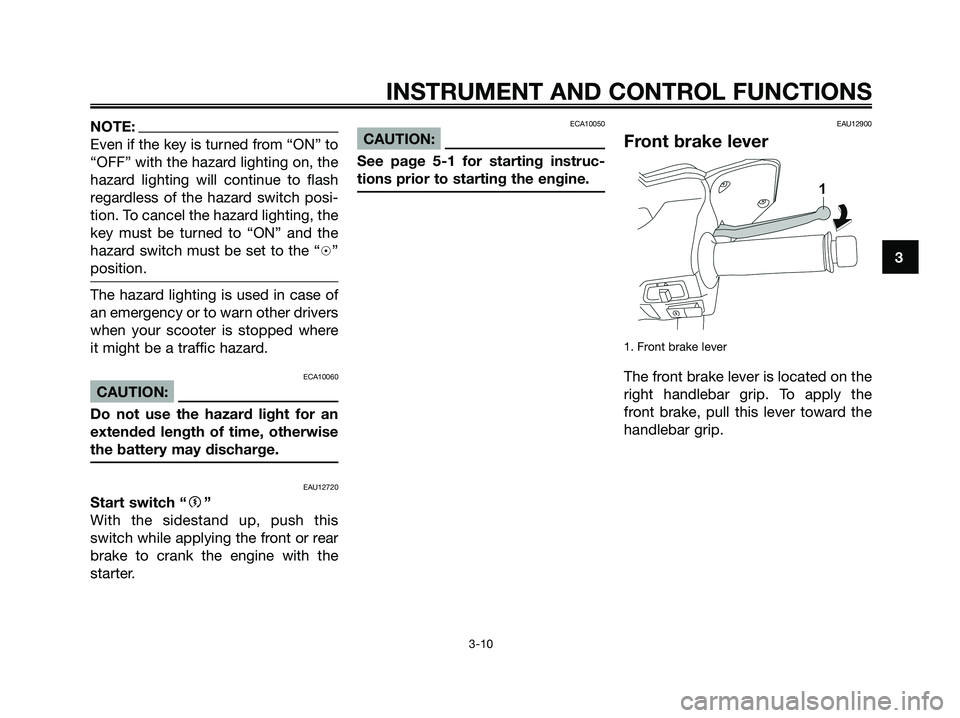
NOTE:
Even if the key is turned from “ON” to
“OFF” with the hazard lighting on, the
hazard lighting will continue to flash
regardless of the hazard switch posi-
tion. To cancel the hazard lighting, the
key must be turned to “ON” and the
hazard switch must be set to the “h”
position.
The hazard lighting is used in case of
an emergency or to warn other drivers
when your scooter is stopped where
it might be a traffic hazard.
ECA10060
CAUTION:
Do not use the hazard light for an
extended length of time, otherwise
the battery may discharge.
EAU12720
Start switch “g”
With the sidestand up, push this
switch while applying the front or rear
brake to crank the engine with the
starter.
ECA10050
CAUTION:
See page 5-1 for starting instruc-
tions prior to starting the engine.
EAU12900
Front brake lever
1. Front brake lever
The front brake lever is located on the
right handlebar grip. To apply the
front brake, pull this lever toward the
handlebar grip.
INSTRUMENT AND CONTROL FUNCTIONS
3-10
3
1B9-F8199-E2.qxd 13/11/07 12:18 Página 25
Page 33 of 88
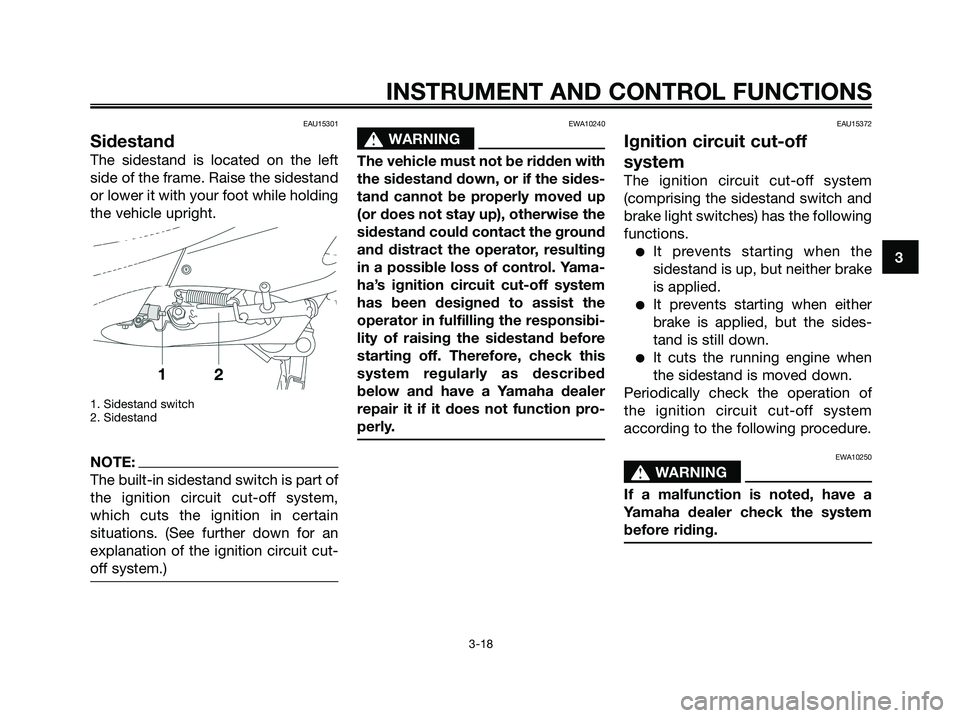
EAU15301
Sidestand
The sidestand is located on the left
side of the frame. Raise the sidestand
or lower it with your foot while holding
the vehicle upright.
1. Sidestand switch
2. Sidestand
NOTE:
The built-in sidestand switch is part of
the ignition circuit cut-off system,
which cuts the ignition in certain
situations. (See further down for an
explanation of the ignition circuit cut-
off system.)
EWA10240
s s
WARNING
The vehicle must not be ridden with
the sidestand down, or if the sides-
tand cannot be properly moved up
(or does not stay up), otherwise the
sidestand could contact the ground
and distract the operator, resulting
in a possible loss of control. Yama-
ha’s ignition circuit cut-off system
has been designed to assist the
operator in fulfilling the responsibi-
lity of raising the sidestand before
starting off. Therefore, check this
system regularly as described
below and have a Yamaha dealer
repair it if it does not function pro-
perly.
EAU15372
Ignition circuit cut-off
system
The ignition circuit cut-off system
(comprising the sidestand switch and
brake light switches) has the following
functions.
●It prevents starting when the
sidestand is up, but neither brake
is applied.
●It prevents starting when either
brake is applied, but the sides-
tand is still down.
●It cuts the running engine when
the sidestand is moved down.
Periodically check the operation of
the ignition circuit cut-off system
according to the following procedure.
EWA10250
s s
WARNING
If a malfunction is noted, have a
Yamaha dealer check the system
before riding.
INSTRUMENT AND CONTROL FUNCTIONS
3-18
3
1B9-F8199-E2.qxd 13/11/07 12:18 Página 33
Page 37 of 88
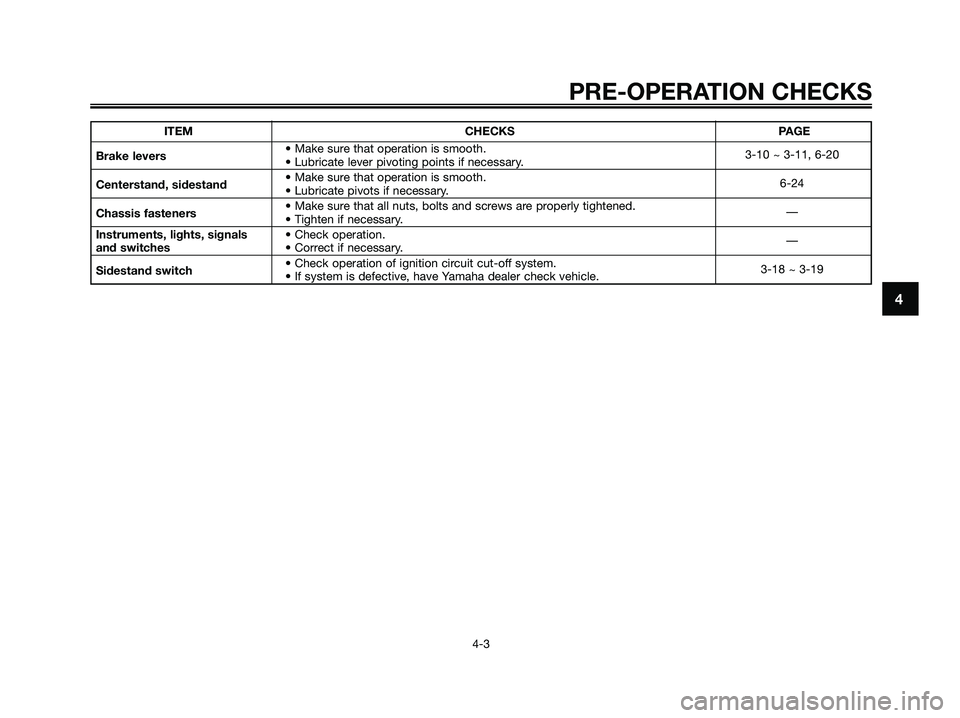
ITEM CHECKS PAGE
Brake levers• Make sure that operation is smooth.
• Lubricate lever pivoting points if necessary.3-10 ~ 3-11, 6-20
Centerstand, sidestand• Make sure that operation is smooth.
• Lubricate pivots if necessary.6-24
Chassis fasteners• Make sure that all nuts, bolts and screws are properly tightened.
• Tighten if necessary.—
Instruments, lights, signals • Check operation.
and switches• Correct if necessary.—
Sidestand switch• Check operation of ignition circuit cut-off system.
• If system is defective, have Yamaha dealer check vehicle.3-18 ~ 3-19
PRE-OPERATION CHECKS
4-3
4
1B9-F8199-E2.qxd 13/11/07 12:18 Página 37
Page 38 of 88
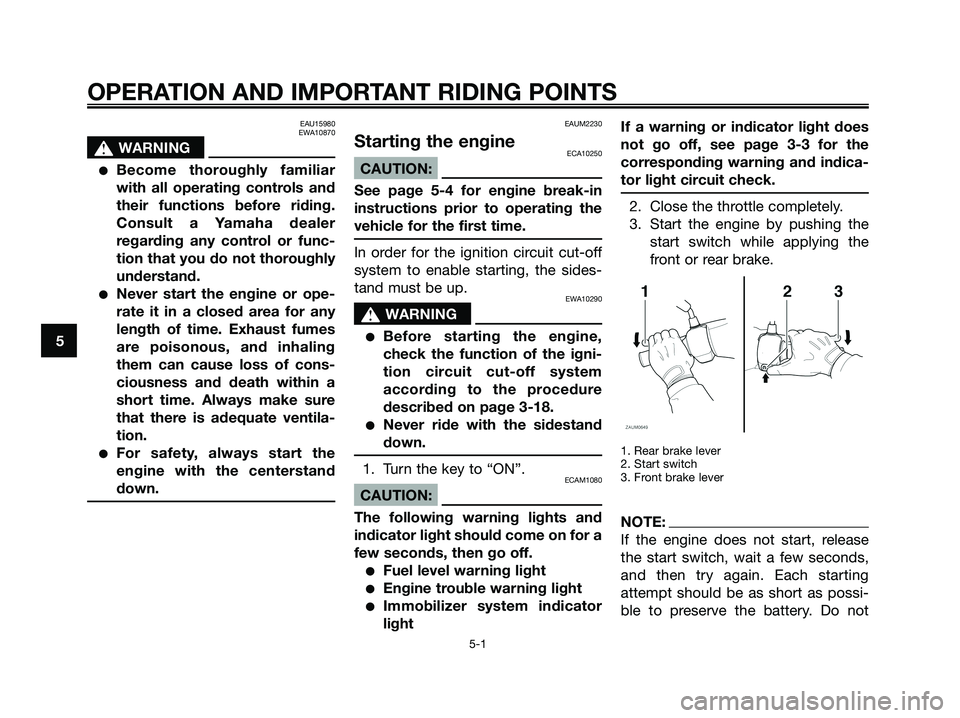
EAU15980
EWA10870
s s
WARNING
●Become thoroughly familiar
with all operating controls and
their functions before riding.
Consult a Yamaha dealer
regarding any control or func-
tion that you do not thoroughly
understand.
●Never start the engine or ope-
rate it in a closed area for any
length of time. Exhaust fumes
are poisonous, and inhaling
them can cause loss of cons-
ciousness and death within a
short time. Always make sure
that there is adequate ventila-
tion.
●For safety, always start the
engine with the centerstand
down.
EAUM2230
Starting the engineECA10250
CAUTION:
See page 5-4 for engine break-in
instructions prior to operating the
vehicle for the first time.
In order for the ignition circuit cut-off
system to enable starting, the sides-
tand must be up.
EWA10290
s s
WARNING
●Before starting the engine,
check the function of the igni-
tion circuit cut-off system
according to the procedure
described on page 3-18.
●Never ride with the sidestand
down.
1. Turn the key to “ON”.ECAM1080
CAUTION:
The following warning lights and
indicator light should come on for a
few seconds, then go off.
●Fuel level warning light
●Engine trouble warning light
●Immobilizer system indicator
lightIf a warning or indicator light does
not go off, see page 3-3 for the
corresponding warning and indica-
tor light circuit check.
2. Close the throttle completely.
3. Start the engine by pushing the
start switch while applying the
front or rear brake.
1. Rear brake lever
2. Start switch
3. Front brake lever
NOTE:
If the engine does not start, release
the start switch, wait a few seconds,
and then try again. Each starting
attempt should be as short as possi-
ble to preserve the battery. Do not
OPERATION AND IMPORTANT RIDING POINTS
5-1
5
1B9-F8199-E2.qxd 13/11/07 12:18 Página 38
Page 40 of 88
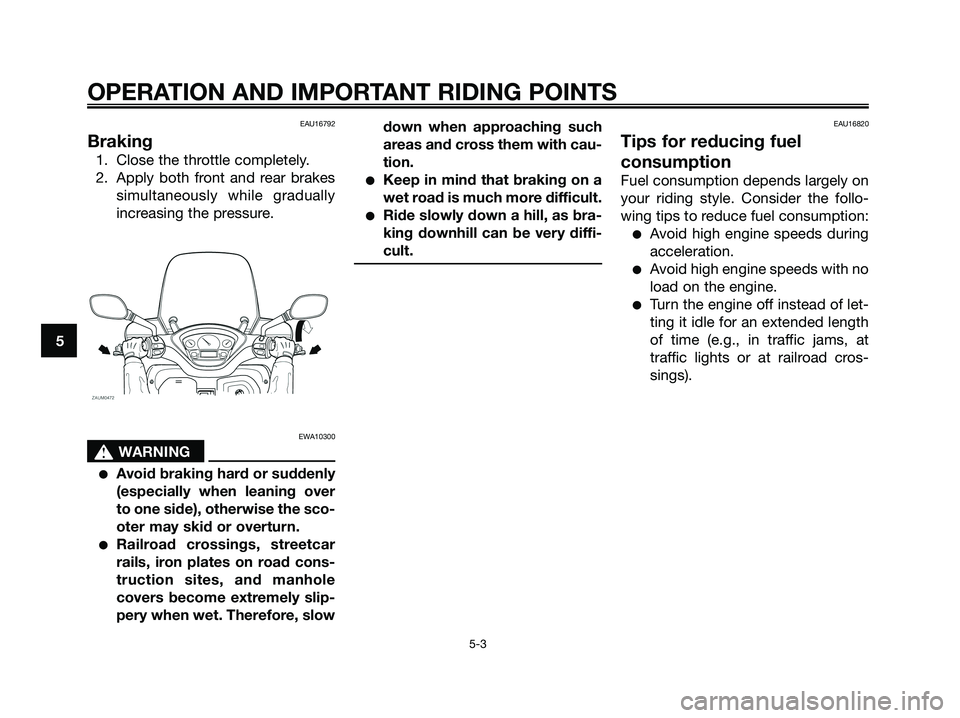
EAU16792
Braking
1. Close the throttle completely.
2. Apply both front and rear brakes
simultaneously while gradually
increasing the pressure.
EWA10300
s s
WARNING
●Avoid braking hard or suddenly
(especially when leaning over
to one side), otherwise the sco-
oter may skid or overturn.
●Railroad crossings, streetcar
rails, iron plates on road cons-
truction sites, and manhole
covers become extremely slip-
pery when wet. Therefore, slowdown when approaching such
areas and cross them with cau-
tion.
●Keep in mind that braking on a
wet road is much more difficult.
●Ride slowly down a hill, as bra-
king downhill can be very diffi-
cult.
EAU16820
Tips for reducing fuel
consumption
Fuel consumption depends largely on
your riding style. Consider the follo-
wing tips to reduce fuel consumption:
●Avoid high engine speeds during
acceleration.
●Avoid high engine speeds with no
load on the engine.
●Turn the engine off instead of let-
ting it idle for an extended length
of time (e.g., in traffic jams, at
traffic lights or at railroad cros-
sings).
OPERATION AND IMPORTANT RIDING POINTS
5-3
5
1B9-F8199-E2.qxd 13/11/07 12:18 Página 40
Page 46 of 88
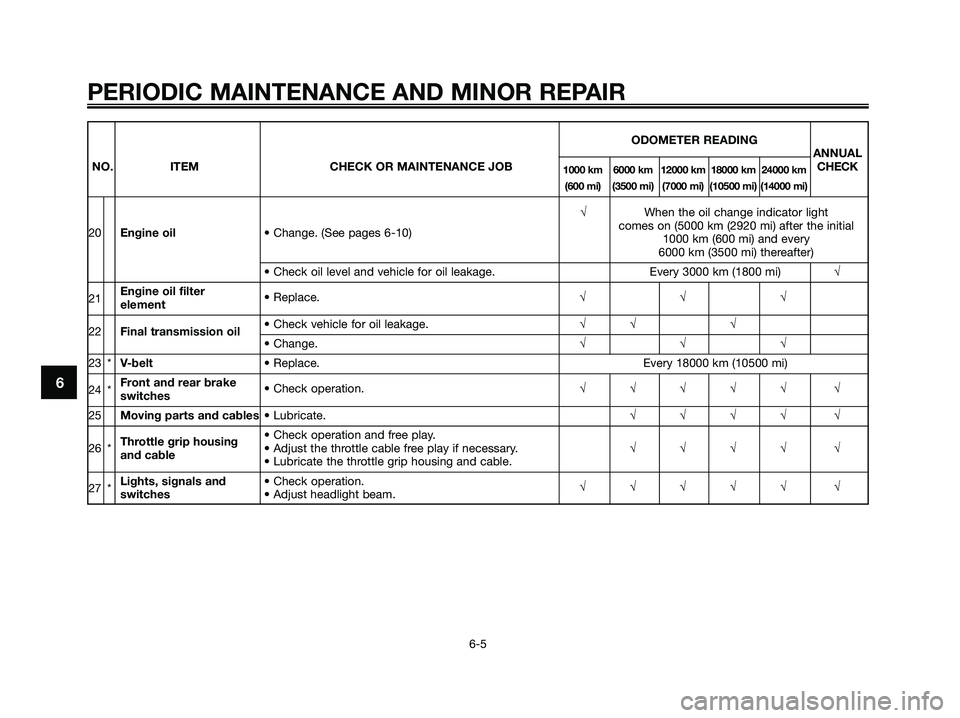
ODOMETER READING
ANNUAL
NO. ITEM CHECK OR MAINTENANCE JOB
1000 km 6000 km 12000 km 18000 km 24000 kmCHECK
(600 mi) (3500 mi) (7000 mi) (10500 mi) (14000 mi)
√When the oil change indicator light
20Engine oil• Change. (See pages 6-10)comes on (5000 km (2920 mi) after the initial
1000 km (600 mi) and every
6000 km (3500 mi) thereafter)
• Check oil level and vehicle for oil leakage. Every 3000 km (1800 mi)√
21Engine oil filter
element• Replace.√√√
22Final transmission oil• Check vehicle for oil leakage.√√ √• Change.√√√
23 *V-belt• Replace. Every 18000 km (10500 mi)
24 *Front and rear brake
switches• Check operation.√√√√√ √
25Moving parts and cables• Lubricate.√√√√ √
Throttle grip housing • Check operation and free play.
26 * • Adjust the throttle cable free play if necessary.√√√√ √
and cable
• Lubricate the throttle grip housing and cable.
27 *Lights, signals and • Check operation.
switches• Adjust headlight beam.√√√√√ √
PERIODIC MAINTENANCE AND MINOR REPAIR
6-5
6
1B9-F8199-E2.qxd 13/11/07 12:18 Página 46
Page 71 of 88

●Headlight lens
• Do not affix any type of tinted
film or stickers to the head-
light lens.
• Do not use a headlight bulb
of a wattage higher than spe-
cified.
5. Install the headlight bulb cover,
and then connect the coupler.
6. Install the cowling.
7. Have a Yamaha dealer adjust the
headlight beam if necessary.
EAU24240
Replacing a front turn signal
light bulb
1. Place the scooter on the centers-
tand.
2. Remove cowling A. (See page 6-7.)
3. Remove the socket (together
with the turn signal light bulb) by
turning it counterclockwise.
1. Turn signal light bulb socket
4. Remove the defective bulb by
pushing it in and turning it coun-
terclockwise.
5. Insert a new bulb into the socket,
push it in, and then turn it clock-
wise until it stops.
6. Install the socket (together with
the bulb) by turning it clockwise.
7. Install the cowling.
EAUS1440
Replacing a tail/brake light
bulb or a rear turn signal
light bulb
1. Place the scooter on the centers-
tand.
2. Open the seat, and then remove
the rear storage compartment.
(See page 3-14.)
1. Rear storage compartment
2. Bolt
3. Remove the tail/brake light and
turn signal light bulb holder by
pulling it outward.
PERIODIC MAINTENANCE AND MINOR REPAIR
6-30
6
1B9-F8199-E2.qxd 13/11/07 12:18 Página 71
Page 72 of 88

1. Bulb socket
1. Push1. Remove
4. Remove the defective bulb by
pushing it in and turning it coun-
terclockwise.
1. Turn signal light bulb
2. Tail/brake light bulb
5. Insert a new bulb into the socket
by pushing it in and turning it
clockwise.
6. Install the bulb holder by pushing
it into the original position.
7. Install the rear storage compart-
ment, and then close the seat.
PERIODIC MAINTENANCE AND MINOR REPAIR
6-31
6
1B9-F8199-E2.qxd 13/11/07 12:18 Página 72
Page 76 of 88

EAU26091
Care
While the open design of a scooter
reveals the attractiveness of the tech-
nology, it also makes it more vulnera-
ble. Rust and corrosion can develop
even if high-quality components are
used. A rusty exhaust pipe may go
unnoticed on a car, however, it
detracts from the overall appearance
of a scooter. Frequent and proper
care does not only comply with the
terms of the warranty, but it will also
keep your scooter looking good,
extend its life and optimize its perfor-
mance.
Before cleaning
1. Cover the muffler outlet with a
plastic bag after the engine has
cooled down.
2. Make sure that all caps and
covers as well as all electrical
couplers and connectors, inclu-
ding the spark plug cap, are
tightly installed.
3. Remove extremely stubborn dirt,
like oil burnt onto the crankcase,
with a degreasing agent and a
brush, but never apply such pro-ducts onto seals, gaskets and
wheel axles. Always rinse the dirt
and degreaser off with water.
Cleaning
ECA10781
CAUTION:
●Avoid using strong acidic whe-
el cleaners, especially on spo-
ked wheels. If such products
are used on hard-to-remove
dirt, do not leave the cleaner on
the affected area any longer
than instructed. Also, tho-
roughly rinse the area off with
water, immediately dry it, and
then apply a corrosion protec-
tion spray.
●Improper cleaning can damage
plastic parts such as cowlings,
panels, windshields, headlight
lenses, meter lenses, etc. Use
only a soft, clean cloth or spon-
ge with mild detergent and
water to clean plastic.
●Do not use any harsh chemical
products on plastic parts. Be
sure to avoid using cloths or
sponges which have been in
contact with strong or abrasivecleaning products, solvent or
thinner, fuel (gasoline), rust
removers or inhibitors, brake
fluid, antifreeze or electrolyte.
●Do not use high-pressure was-
hers or steam-jet cleaners sin-
ce they cause water seepage
and deterioration in the follo-
wing areas: seals (of wheel and
swingarm bearings, fork and
brakes), electric components
(couplers, connectors, instru-
ments, switches and lights),
breather hoses and vents.
●For scooters equipped with a
windshield: Do not use strong
cleaners or hard sponges as
they will cause dulling or scrat-
ching. Some cleaning com-
pounds for plastic may leave
scratches on the windshield.
Test the product on a small hid-
den part of the windshield to
make sure that it does not lea-
ve any marks. If the windshield
is scratched, use a quality
plastic polishing compound
after washing.
SCOOTER CARE AND STORAGE
7-1
7
1B9-F8199-E2.qxd 13/11/07 12:18 Página 76